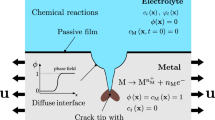Abstract
We deduce an equation for determination of the electric potential in a deformed metal caused by the redistribution of electric charges in the process of deformation. We assume that the charge density of the crystal lattice is determined by a relative change in the volume, and the charge density of the electron gas is determined by the condition of constancy of the electrochemical potential of electrons over the entire volume of the metal. We formulate conditions for the deformable metal–corrosion medium interface and, as an example, consider an infinite metal body containing a circular hole filled by the corrosion medium.
Similar content being viewed by others
REFERENCES
E. M. Zaretskii, “Influence of deformation on the potential of materials,” Zh. Prikl. Khim., No. 6, 614–623 (1951).
H. V. Karpenko, I. E. Zamostyanik, Yu. I. Babei, and V. I. Pokhmurs'kyi, “Determination of stresses in microvolumes of a metal with the use of the electrode potential,” Fiz.-Khim. Mekh. Mater., 5, No. 5, 635–636 (1969).
I. M. Dmytrakh, “Influence of tensile stresses on parameters of corrosion processes in model cracks-slots,” Fiz.-Khim. Mekh. Mater., 26, No. 4, 22–25 (1990).
L. N. Petrov, Corrosion under Stress [in Russian], Vyshcha Shkola, Kiev (1986).
J. M. Ziman, Electrons and Phonons. The Theory of Transport Phenomena in Solids, Clarendon Press, Oxford (1960).
J. M. Ziman, Principles of the Theory of Solids, Cambridge University Press, Cambridge (1972).
C. Kittel, Introduction to Solid State Physics, Wiley, New York (1974).
B. I. Kolodii, “Original relations for determination of the interaction of a deformed metal with the corrosion environment,” in: V. V. Panasyuk (editor), Mechanics of Fracture of Materials and Strength of Structures [in Ukrainian], Vol. 2, Issue 2, Kamenyar, Lviv (1999), pp. 172–175.
Ya. I. Burak, B. P. Halapats, and B. M. Hnidets', Physicomechanical Processes in Conductive Bodies [in Ukrainian], Naukova Dumka, Kiev (1978).
V. V. Skorcheletti, Theoretical Electrochemistry [in Russian], Gosudarstvennoe Nauchno-Tekhnicheskoe Izdatel'stvo Khimicheskoi Literatury, Leningrad (1963).
W. R. Smythe, Static and Dynamic Electricity, New York (1950).
M. G. Stashchuk, B. I. Kolodii, and V. G. Horopats'kyi, “Analytic investigation of the influence of a stress-strain state on a change in the electrode potential of the metal surface along its boundary with the corrosion medium,” in: Mechanics and Physics of Building Materials of Constructions [in Ukrainian], Kamenyar, Lviv (1998), pp. 548–554.
N. I. Muskhelishvili, Some Basic Problems of the Mathematical Theory of Elasticity [in Russian], Nauka, Moscow (1966).
H. Brooks, “Electron structure of transition metals,” in: P. A. Beck (editor), Electronic Structure and Alloy Chemistry of the Transition Elements [Russian translation], Metallurgiya, Moscow (1966).
Author information
Authors and Affiliations
Rights and permissions
About this article
Cite this article
Kolodii, B.I. Theoretical Investigation of the Interaction of a Deformed Metal with a Corrosion Medium. Materials Science 36, 884–891 (2000). https://doi.org/10.1023/A:1011343022972
Issue Date:
DOI: https://doi.org/10.1023/A:1011343022972




